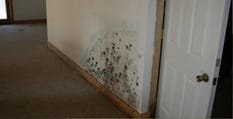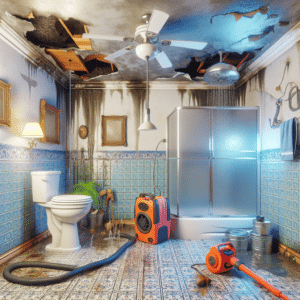
Spring is back! Along with the return of wonderful things like longer days and warmer temperatures, there’s also the chance that mold will affect your property.
While mold is a year-round issue, it becomes even more problematic during the spring. The ground that was frozen all winter starts to thaw and mold that was lying dormant begins to spread again. Mold spores will once again fill the air and seek out their favorite food sources (wood and drywall) and best places to thrive (any areas with water damage and/or high levels of moisture and humidity).
To help you stay one step ahead of mold this spring and summer, we’ve compiled a list of simple tips to prevent mold growth in your property.
Clean Your Gutters and Downspouts
Gutters keep rainwater from collecting on your roof. Downspouts funnel that water away from your property so it can be absorbed by the ground. This system helps keep rainwater from entering your home and causing water damage – and mold growth.
Unfortunately, gutters and downspouts typically get clogged with dirt and debris during the late fall and winter months. When this happens, the gutters and downspouts cannot properly move water off roofs and aways from houses. This often results in water damage and mold growth.
To prevent these issues from affecting your property it’s best to clean your gutters and downspouts during the early days of spring. By removing leaves, twigs, dirt and debris from your rooftop drainage system, you’ll help them do their job more effectively and protect your home from the dangers of water damage and mold.
Clean Your Drip Pans
As the temperatures rise, you’ll rely on your AC to keep your home comfortable. And in order to keep your home comfortably cool, AC’s create a lot of moisture. To prevent this moisture from damaging your home, the AC is outfitted with a drip pan.
Resting under the unit, a drip pan collects the moisture that develops on the AC coils while it’s in operation. It basically works just like a coaster that prevents falling beads of condensation on a cold glass of water from damaging furniture.
Similar to the problem with clogged gutters and downspouts, if the drip pan clogs and overflows, it causes water damage which leads to mold. To prevent this from happening, you should inspect your drip pan for clogs and cracks. If you notice that water is overflowing from your unit, but cannot find a clog or crack, it’s best to shut it off and schedule an appointment with your AC service provider to correct this potential problem.
Properly Vent Your Dryer
While the idea of drying laundry in the spring and summer breezes sounds wonderful, it can result in allergens collecting on your clothes. Luckily, dryers help avoid this scenario.
Dryers, if not vented properly, can cause issues inside your home. To effectively dry your clothes, these appliances create an excessive amount of heat. That heat creates a great deal of humidity that causes moisture which needs to be removed from your dryer. The ventilation system accomplishes this by removing moisture and lint from the dryer unit.
Unfortunately, many folks do not properly vent their dryers to the outside. They also don’t ensure that their vents are free of lint that builds up and causes clogs. When this happens, the excess moisture blows into the house. Over time, that moisture results in mold growth in the area where your dryer is located.
To prevent this from happening, make sure your dryer is properly vented to the exterior of your house. Be sure the vent is blowing away from any doors and windows so the moisture does not enter your house through the seams. To prevent logged vents, you should schedule an annual inspection with a qualified maintenance provider.
Cover Dirt In Your Crawl Space
Many homes in the Gold Coast, NJ area have crawl spaces instead of basements due to the threat of floods. While crawl spaces can protect homes during floods, they may still be breeding grounds for mold. Moisture vapors from the dirt in the crawl spaces can enter homes and cause mold to grow.
To prevent this from happening, the crawl space will need a vapor barrier. If your home has a crawl space, you should cover the dirt with plastic. This barrier prevents moisture from escaping and causing mold damage to your property.
Helpful hint: before you add the plastic cover to your crawl space, make sure that the dirt is dry and not wet or damp. If it is, you’ll need to dry it out with fans before applying the cover.
Do Not Carpet Your Basement
Finished basements are wonderful places to spend time and entertain guests. Although carpeting looks great in the basement, it’s quite problematic during floods and water damage. If not properly cleaned and effectively dried, the moisture it collected will generate mold.
Using area rugs in the basement not only provides the appearance of carpeting, they’re much easier to remove in the event of flooding. Quickly removing wet area rugs allows the floor to dry more effectively and minimizes the possibility of mold growth.
Now that you know some of the best ways to stop the spread of mold in your house, you’ll be able to have a much more enjoyable spring and summer!
If you do experience a mold emergency (or you currently suspect mold in your household), you should never try to solve the problem on your own. Instead, you should trust a firm that specializes in mold testing and remediation.
FloodCo USA not only specializes in water damage restoration, we also provide certified mold testing and remediation services, too!
Contact us today if you require IICRC-certified mold remediation services for your home or business!



